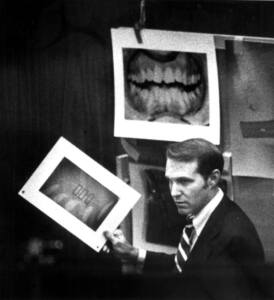Bite Marks

Bite marks are typically found on the breasts, legs, and genitalia, and are usually part of a sexual assault. Marks can also be seen on the attacker’s hands, arms and sometimes face.
Once a bite mark is found on an injured party or suspect it is important for a forensic dentist to be called right away to make sure that (a) the bite mark is human and (b) that the bite mark is not self-inflicted. The forensic dentist must be called right away because bite marks change over time. To make sure that the mark is human, the forensic dentist can look at the bite mark pattern, because animals leave a different bite pattern than humans. Human bite marks are often elliptical or circular in shape and display traits of the teeth used to make the mark. To determine whether or not it was self inflicted, DNA testing can be used on the saliva that the biter left behind. This DNA testing could also help find the suspect. Once these things are determined it is important to record the bite mark properly. A forensic dentist must measure and record each individual bite mark and take many photographs because of how easily it is for the bite mark to change. For example, bruising may appear four hours after the bite and then disappear 36 hours later. Due to the fact that the photography of the marks must be done precisely, a forensic dentist might have to wait until the lividity stage (the stage where the pooling of the blood clears and details become visible) to take pictures. Also on deceased victims, after photographs are taken the final step is to cut out the bite mark, make a silicone cast of the mark and then preserve the original mark in formalin. All bite mark samples at the scene should be collected, not just the marks on the body but marks found such as in food or on a pencil that has been chewed.
Bite marks, like fingerprints are unique to every single person, this means an investigator can tell a lot about the perpetrator or biter, which can make the hunt for a suspect easier. A gap in the bite mark means that there is the potential of a tooth missing. This means that they are looking for a suspect who is missing a tooth, but not just any tooth; it has to be a specific tooth that matches with the gap in the bite mark. If the bite marks found on the victim are crooked it signifies that the biter has crooked teeth, which helps narrow down suspects. Teeth that are chipped leave marks that are jagged and of various depths. Braces and partials also narrow down suspects because they too leave unique marks.
Other factors that can affect the way that a bite mark looks are:
• The movement of the biters jaw and tongue when they bit
• The location of the bite
• Whether or not the biting victim was moving when they were bit.
Once a suspect is found that matches the trait that the investigator has found, whether it be a specific tooth that’s missing, crooked teeth, or jagged teeth, whether or not the suspect has braces or partials they can look at whether or not the suspect was the biter or not. In order to collect a sample bite mark from the suspect, an investigator must obtain a warrant and then they can proceed to make a mold of the suspect’s teeth as well as take photos of the suspect’s mouth in various positions. After these molds and photos are obtained comparison between the sample marks and the marks on the victim can start. Investigators compare translucencies of the sample bite mark mold to the bite mark silicone cast and compare pictures of the bite mark to pictures of the suspect’s teeth to find similarities.
Back to Forensic Investigation
Back to Crime Library
|
|
|

